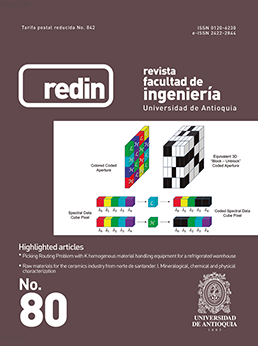Densificación con explosivos: una metodología propuesta para cuantificar el grado de densificación requerida para prevenir licuación y flujo en suelos arenosos
DOI:
https://doi.org/10.17533/udea.redin.n80a07Palabras clave:
densificación con explosivos, densificación, arenas sueltas, licuación, mejoramiento de suelosResumen
Este trabajo presenta una metodología para cuantificar el grado de densificación por explosivos o número de detonaciones requeridos para prevenir licuación y flujo en suelos arenosos sueltos y saturados, en un determinado proyecto. La metodología propuesta está basada en los conceptos de estado crítico de mecánica de suelos, y el número de detonaciones se escoge, de tal manera, que el estado final de esfuerzos del horizonte dinamitado, se localice por debajo de la línea de estado crítico del suelo, donde se espera una respuesta dilatante. Se presentan y utilizan los resultados obtenidos de ensayos de campo y laboratorio de un programa de densificación con explosivos en un relleno sanitario localizado en Carolina del Sur, Estados Unidos, con el objeto de evaluar el enfoque propuesto. Se presenta un ejemplo detallado paso a paso con éste propósito. Esta metodología puede proveer a ingenieros una manera racional de estimar que tanto mejoramiento se requiere en el suelo para alcanzar las condiciones de diseño de un proyecto en particular, así como los costos asociados a éste mejoramiento.
Descargas
Citas
W. Gohl, M. Jefferies, J. Howie and D. Diggle, “Explosive compaction: design, implementation and effectiveness”, Géotechnique, vol. 50, no. 6, pp. 657- 665, 2000.
C. Vega, “Evaluation of liquefaction susceptibility of clean sands after blast densification”, Ph.D. dissertation, Northwestern University, Evanston, IL, USA, 2012.
C. Vega, D. Zapata and E. García, “Ground surface settlement of loose sands densified with explosives”, Revista Facultad de Ingeniería Universidad de Antioquia, vol. 70, pp. 9-17, 2014.
G. Narsilio, “Spatial variability and terminal density: Implication in soil behavior”, Ph.D dissertation, Georgia Institute of Technology, Atlanta, GA, USA, 2006.
G. Narsilio, J. Santamarina, T. Hebeler and R. Bachus, “Blast Densification: Multi-Instrumented Case History”, Journal of Geotechnical and Geoenvironmental Engineering, vol. 135, no. 6, pp. 723-734, 2009.
A. Schofield and P. Wroth, Critical state soil mechanics, 1st ed. USA: McGraw-Hill, 1968.
R. Bachus, T. Hebeler, J. Santamarina, M. Othman and G. Narsilio, “Use of field instrumentation and monitoring to assess ground modification by blast densification”, in 15th Great Lakes Geotechnical/ Geoenviromental Conference (GLGGC), Indianapolis, USA, 2008, pp. 3-36.
P. Mayne, NCHRP Synthesis 368, Cone Penetration Testing, 1st ed. Washigton, D.C., USA: Transportation Research Board, 2007.
American Society for Testing Materials (ASTM), Standard Practice for Dry Preparation of Soil Samples for Particle-Size Analysis and Determination of Soil Constants, Standard ASTM D421-85, 2007.
American Society for Testing Materials (ASTM), Standard Test Method for Particle-Size Analysis of Soils, Standard ASTM D422-63, 2007.
American Society for Testing Materials (ASTM), Standard Test Methods for Specific Gravity of Soil Solids by Water Pycnometer, Standard ASTM D854-14, 2014.
American Society for Testing Materials (ASTM), Standard Test Methods for Maximum Index Density and Unit Weight of Soils Using a Vibratory Table, Standard ASTM D4253-14, 2014.
American Society for Testing Materials (ASTM), Standard Test Methods for Minimum Index Density and Unit Weight of Soils and calculation of Relative Density, Standard ASTM D4254-14, 2014.
Descargas
Publicado
Cómo citar
Número
Sección
Licencia
Derechos de autor 2016 Revista Facultad de Ingeniería Universidad de Antioquia

Esta obra está bajo una licencia internacional Creative Commons Atribución-NoComercial-CompartirIgual 4.0.
Los artículos disponibles en la Revista Facultad de Ingeniería, Universidad de Antioquia están bajo la licencia Creative Commons Attribution BY-NC-SA 4.0.
Eres libre de:
Compartir — copiar y redistribuir el material en cualquier medio o formato
Adaptar : remezclar, transformar y construir sobre el material.
Bajo los siguientes términos:
Reconocimiento : debe otorgar el crédito correspondiente , proporcionar un enlace a la licencia e indicar si se realizaron cambios . Puede hacerlo de cualquier manera razonable, pero no de ninguna manera que sugiera que el licenciante lo respalda a usted o su uso.
No comercial : no puede utilizar el material con fines comerciales .
Compartir igual : si remezcla, transforma o construye a partir del material, debe distribuir sus contribuciones bajo la misma licencia que el original.
El material publicado por la revista puede ser distribuido, copiado y exhibido por terceros si se dan los respectivos créditos a la revista, sin ningún costo. No se puede obtener ningún beneficio comercial y las obras derivadas tienen que estar bajo los mismos términos de licencia que el trabajo original.










 Twitter
Twitter